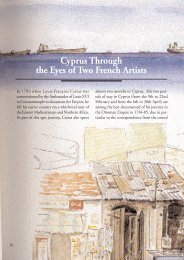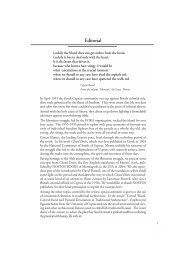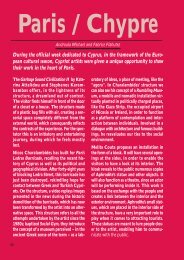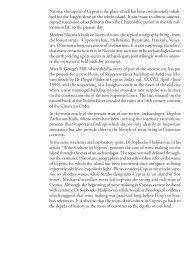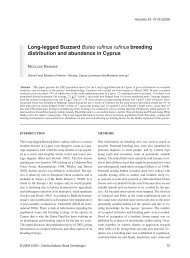Editorial
Editorial
Editorial
Create successful ePaper yourself
Turn your PDF publications into a flip-book with our unique Google optimized e-Paper software.
Different stages in the production of oil. 16th century engraving.<br />
The olive tree suits all types of cultivation.<br />
According to consular reports of the 19th century,<br />
olive trees were constantly found with<br />
the carob trees at the foot of the mountains<br />
and skirting the plains, forming a line of demarcation<br />
between the uncultivated mountain<br />
sides, and the tilled land below (report by the<br />
Vice-Consul White in Papadopoullos 1980,<br />
83. See also Savile 1878, 93). At the same time<br />
there were olive groves, lioforia, which came<br />
right up to the walls of Nicosia. An area of the<br />
capital is still called "Elaion" today and, despite<br />
the fact that large modern villas are built on<br />
it, a number of olive trees still grow there.<br />
Olive trees were included in records of property<br />
and the number of olive roots is recorded<br />
in inventories of property and marriage<br />
contracts (e.g. in the 18th unpublished inventory<br />
of the property of the Dragoman Hadjigeorgakis<br />
Kornessios).<br />
In an economy that was primarily agricultural,<br />
like that of Cyprus, olive oil was only second<br />
to wheat as a food staple. Therefore, interregional<br />
exchanges were essential and itinerant<br />
merchants and even producers would<br />
exchange olive oil with grain.<br />
The production of olive oil fluctuated considerably.<br />
It did not always meet local needs<br />
and only in good years was there the possibility<br />
of exporting. This phenomenon seems<br />
to have been perpetual. At the end of the 18th<br />
century Archimandrite Kyprianos gives the<br />
following picture: "The olive groves produce<br />
a good quantity of oil so that when they<br />
do well the country is provided for up to three<br />
years and sometimes it is even sent out of<br />
the country" (Kyprianos (1788) 1974, 544),<br />
while in 1868, in the report of the Vice-Consul<br />
Sandwith on the merchants of Cyprus, it<br />
is mentioned that Cyprus is the only island in<br />
the East which does not produce sufficient oil<br />
for its needs (Papadopoullos 1980, 116).<br />
5





